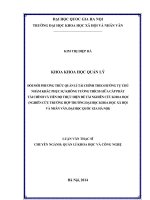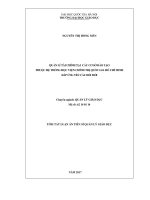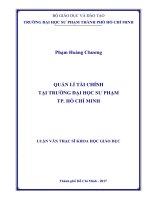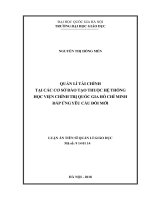quản lí tài chính
Bạn đang xem bản rút gọn của tài liệu. Xem và tải ngay bản đầy đủ của tài liệu tại đây (322.82 KB, 60 trang )
Chapter 15 - Exporting, Importing, and Countertrade
Chapter 15
Exporting, Importing, and Countertrade
True / False Questions
.c
om
1. As exporting has become easier, the volume of export activity in the world economy has
been rising.
True False
ng
2. Large revenue and profit opportunities are typically available in foreign markets.
True False
th
an
co
3. Proactive firms do not consider exporting until their domestic market is saturated and the
emergence of excess productive capacity at home forces them to look for growth
opportunities in foreign markets.
True False
u
du
o
ng
4. Typically, large companies are not very proactive in seeking opportunities for profitable
exporting.
True False
cu
5. Many small and medium-sized firms tend to go out into the world to seek opportunities,
rather than wait for the world to come to them.
True False
6. Many firms are not proactive simply because of their ignorance of foreign market
opportunities.
True False
15-1
CuuDuongThanCong.com
/>
Chapter 15 - Exporting, Importing, and Countertrade
7. According to the UN, a typical international trade transaction can involve 50 different
parties.
True False
.c
om
8. Many foreign customers require face-to-face negotiations on their home turf.
True False
ng
9. A big impediment to exporting is the simple lack of knowledge of the opportunities
available.
True False
th
an
co
10. Unlike their American and Japanese counterparts, German firms are at a disadvantage
when it comes to assistance in seeking export opportunities.
True False
du
o
ng
11. For American companies, the most comprehensive source of export information is the
local government trade department.
True False
cu
u
12. U.S. firms interested in exporting can acquire a "best prospects" list of opportunities from
the U.S. Department of Commerce and its district offices all over the country.
True False
13. The Small Business Administration is a good source of export assistance.
True False
15-2
CuuDuongThanCong.com
/>
Chapter 15 - Exporting, Importing, and Countertrade
14. An export management company is an export specialist who acts as the export marketing
department or international department for their client firms.
True False
.c
om
15. EMCs are experienced specialists who can help the neophyte exporter avoid common
pitfalls.
True False
ng
16. To export successfully, it often makes sense to focus initially on a handful of markets.
True False
th
an
co
17. Entering a foreign market on a large scale provides the opportunity to learn about the
foreign country.
True False
du
o
ng
18. A shotgun approach to exporting will almost always result in that firm becoming
established in any one market.
True False
cu
u
19. One of the reasons for the lack of trust between firms engaged in international trade is due
to the problems of using an underdeveloped international legal system to enforce contractual
obligations.
True False
20. The letter of credit system has evolved to create a less risky environment for international
trade.
True False
15-3
CuuDuongThanCong.com
/>
Chapter 15 - Exporting, Importing, and Countertrade
21. The letter of credit is issued by the bank at the request of an exporter.
True False
.c
om
22. The sight draft specifies that the bank will pay a specified sum of money to the exporter
upon the presentation of specified documents.
True False
ng
23. The letter of credit system effectively transfers the issue of trust to the bank.
True False
an
co
24. International transactions are usually settled using drafts.
True False
du
o
ng
th
25. Because of the lack of trust in international transactions, payment or a formal promise to
pay is required before the buyer can obtain the merchandise.
True False
cu
u
26. Time drafts are negotiable instruments.
True False
27. Once a time draft is stamped with an acceptance, the maker can sell the draft at a premium
to its face value.
True False
28. The bill of lading acts as a receipt, a contract, and a document of title.
True False
15-4
CuuDuongThanCong.com
/>
Chapter 15 - Exporting, Importing, and Countertrade
29. The bill of lading can act as collateral against which the exporter can draw funds.
True False
.c
om
30. The mission of the Eximbank is to provide financing aid that will facilitate exports,
imports, and the exchange of commodities between the U.S. and other countries.
True False
ng
31. The Eximbank is a part of the WTO's efforts to facilitate trade between nations.
True False
th
an
co
32. American exporters can minimize their risk by purchasing insurance from the Foreign
Credit Insurance Association.
True False
du
o
ng
33. When conventional means of payment are difficult, a firm might turn to countertrade as a
means of structuring an international sale.
True False
cu
u
34. Firms use countertrade to trade goods and services for other goods and services when they
cannot be traded for money.
True False
35. Countertrading is a common solution for nonconvertibility of currency.
True False
36. Barter is the simplest form of countertrade.
True False
15-5
CuuDuongThanCong.com
/>
Chapter 15 - Exporting, Importing, and Countertrade
37. An offset agreement occurs when a firm agrees to purchase a certain amount of materials
back from a country to which a sale is made.
True False
.c
om
38. Switch trading is the direct exchange of goods and/or services between parties without a
cash transaction.
True False
co
ng
39. Countertrade contracts may involve the exchange of poor-quality goods that the firm
cannot dispose of profitably.
True False
du
o
Multiple Choice Questions
ng
th
an
40. Unless there is no alternative, large, diverse multinational enterprises should probably try
to avoid countertrade deals.
True False
cu
u
41. Which of the following is true of exporting?
A. It helps firm achieve economies of scale
B. It creates diseconomies of scale
C. It increases unit costs
D. It creates diseconomies of scope
42. In terms of seeking export opportunities, studies have shown that:
A. almost all small firms tend to be proactive about seeking profitable export opportunities.
B. most large firms tend to be reactive about seeking export opportunities.
C. most small firms systematically scan foreign markets to see where the opportunities lie.
D. many medium-sized and small firms are very reactive.
15-6
CuuDuongThanCong.com
/>
Chapter 15 - Exporting, Importing, and Countertrade
43. Which of the following is true of reactive firms?
A. They may not even consider exporting until their domestic market is saturated
B. They create excess productive capacity and actively hunt for opportunities in foreign
markets
C. Almost all large firms fall under this category
D. They systematically scan foreign markets for profitable export opportunities
co
ng
.c
om
44. Which of the following helps explain why exporters still account for only a tiny
percentage of U.S. firms?
A. Lack of export opportunities; buoyant demand within U.S.
B. Tariffs; FDI restrictions
C. Unfamiliarity; intimidation by the complexities
D. Regulatory burden; barriers to free trade
du
o
ng
th
an
45. Japanese exporters get assistance in identifying export opportunities from:
A. MITI.
B. the Japanese Outreach Program.
C. guanxi.
D. chaebol.
cu
u
46. Great trading houses in Japan are called:
A. kaizen.
B. sogo shosha.
C. MITI.
D. gaunxi.
47. Unlike their German and Japanese competitors, U.S. firms are _____ when they see
export opportunities.
A. information-disadvantaged
B. money-strapped
C. regulation-bound
D. much better prepared
15-7
CuuDuongThanCong.com
/>
Chapter 15 - Exporting, Importing, and Countertrade
48. In terms of international comparisons, which of the following statement is false?
A. Japanese firms can draw on the large reservoirs of experience of its export-oriented
institutions.
B. The United States has been a relatively self-contained continental economy until recently.
C. Many German firms are relatively blind when they seek export opportunities.
D. Japan has long made its living as a trading nation.
ng
.c
om
49. For U.S. firms, the most comprehensive source of export opportunities information is the:
A. Small Business Administration.
B. U.S. Department of Commerce.
C. Federal Trade Commission.
D. foreign embassy.
du
o
ng
th
an
co
50. The agencies of the U.S. Department of Commerce provide the potential exporter with all
of these services except:
A. matchmaker programs.
B. trade events and exhibitions.
C. best prospects lists.
D. export subsidies.
cu
u
51. A "best prospects" list:
A. gives the names and addresses of potential distributors in the domestic market.
B. is provided by the United States and Foreign Commercial Service Agency.
C. can provide a firm free, customized market research survey on any product.
D. provides information gathering, technical assistance, and export subsidies.
15-8
CuuDuongThanCong.com
/>
Chapter 15 - Exporting, Importing, and Countertrade
.c
om
52. Which of the following is not provided by the Department of Commerce?
A. It provides the potential exporter with a "best prospects" list, which gives the names and
addresses of potential distributors in foreign markets.
B. It has assembled a "comparison shopping service" for 14 countries that are major markets
for U.S. exports.
C. It coordinates the Export Legal Assistance Network (ELAN), a nationwide group of
international trade attorneys who provide free initial consultations to small businesses on
export-related matters.
D. It organizes trade events that help potential exporters make foreign contacts and explore
export opportunities.
th
an
co
ng
53. The Department of Commerce has a _____ program, in which department representatives
accompany groups of U.S. businesspeople abroad to meet with qualified agents, distributors,
and customers.
A. best prospects
B. matchmaker
C. trade events
D. comparison shopping
cu
u
du
o
ng
54. Which of the following statements about the SBA is false?
A. It is the most comprehensive source of export opportunities information.
B. It employs 10 regional international trade officers throughout the United States.
C. It employs a 10-person international trade staff in Washington, D.C.
D. It oversees some 850 volunteers to provide one-on-one counseling to active and new-toexport businesses.
55. Which of the following is a nationwide group of international trade attorneys who provide
free initial consultations to small businesses on export-related matters?
A. EMC
B. SBA
C. ELAN
D. SCORE
15-9
CuuDuongThanCong.com
/>
Chapter 15 - Exporting, Importing, and Countertrade
56. Through its _____ program, the SBA oversees some 850 volunteers with international
trade experience to provide one-on-one counseling to active and new-to-export businesses.
A. EMC
B. SCORE
C. ELAN
D. International Trade Administration
co
ng
.c
om
57. _____ is an export specialist who acts as the export marketing department or international
department for its client firm.
A. An Eximbank
B. An import trading company
C. A sogo shosha
D. An export management company
du
o
ng
th
an
58. In theory, the advantage of EMCs is that they:
A. provide export subsides to the exporting firms.
B. are not-for-profit organizations, hence provide free service.
C. are subsidized by the Department of Commerce.
D. are experienced specialists who can help the neophyte exporter.
cu
u
59. One drawback of relying on EMCs is that:
A. they are not conversant with the ins and outs of the exporting process.
B. they have no knowledge of different business mores.
C. the company can fail to develop its own exporting capabilities.
D. the company is unable to avoid common pitfalls.
60. A firm can increase the probability of exporting successfully by taking which of these
steps?
A. Avoiding hiring EMCs to lower head counts
B. Hiring only home country personnel to build commitment
C. Entering on a small scale
D. Waiting for the export opportunities to come
15-10
CuuDuongThanCong.com
/>
Chapter 15 - Exporting, Importing, and Countertrade
ng
62. A key challenge facing export and import financing is:
A. limited market opportunities.
B. lack of export assistance.
C. lack of qualified EMCs.
D. the lack of trust.
.c
om
61. Which of the following is not true about exporting?
A. A firm needs to be proactive about seeking export opportunities
B. Exporting is almost always an end in itself
C. It is important for the exporter to retain the option of local production
D. Localization can lead to greater market acceptance
ng
th
an
co
63. Which of the following states that the bank will pay a specified sum of money to a
beneficiary on presentation of particular, specified documents?
A. A draft
B. A bill of lading
C. A letter of credit
D. A promissory note
cu
u
du
o
64. Which of the following is also referred to as a "bill of exchange"?
A. A letter of credit
B. A bill of lading
C. A draft
D. A promissory note
65. A draft:
A. is a document requesting payment.
B. is the same as a letter of credit.
C. is a reciprocal buying agreement.
D. gives title to shipped goods.
15-11
CuuDuongThanCong.com
/>
Chapter 15 - Exporting, Importing, and Countertrade
66. In a letter of credit transaction, the importer secures the letter of credit
A. before product shipment.
B. after product shipment.
C. from the exporter's bank.
D. after receiving the product.
ng
.c
om
67. In a letter of credit transaction, the exporter ships the product
A. after the letter of credit is issued.
B. before the letter of credit is issued.
C. upon receipt of payment.
D. with the bill of lading.
ng
th
an
co
68. In a letter of credit transaction, the exporter receives its payment from
A. the importer.
B. the importer's bank.
C. the exporter's bank.
D. the government.
cu
u
du
o
69. What is the biggest advantage of using a letter of credit system?
A. The exporter is guaranteed pre-export financing.
B. It allows the importer time to resell the merchandise before requiring payment.
C. The trust is established, for the importer and exporter, because of a reputable bank.
D. It guarantees the importer extra funds for other purposes.
70. What is the drawback of using a letter of credit system?
A. The exporter is no longer entitled to preexport financing
B. The importer no longer trusts the exporter
C. The exporter is not guaranteed any payment
D. The importer must pay the bank a fee for the letter of credit
15-12
CuuDuongThanCong.com
/>
Chapter 15 - Exporting, Importing, and Countertrade
co
ng
th
an
73. A _____ allows for a delay in payment.
A. bill of lading
B. time draft
C. banker's acceptance
D. sight draft
ng
72. A _____ is payable on presentation to the drawee.
A. time draft
B. bill of lading
C. sight draft
D. trade acceptance
.c
om
71. The person or business initiating a draft is known as the:
A. beneficiary.
B. drawee.
C. maker.
D. trustor.
cu
u
du
o
74. A banker's acceptance:
A. is payable immediately on presentation to the drawee.
B. allows a buyer possession of the merchandise without signing a formal document.
C. is a time draft that has been drawn on and accepted by a bank.
D. is the same as a sight draft.
75. The bill of lading serves all of the following purposes except:
A. it is a receipt.
B. it is a bank note.
C. it is a contract.
D. it is a document of title.
15-13
CuuDuongThanCong.com
/>
Chapter 15 - Exporting, Importing, and Countertrade
76. A bill of lading:
A. is the same as a letter of credit.
B. is received from the importer prior to product shipment.
C. is a financial note issued by a bank.
D. gives title to the goods.
ng
.c
om
77. All of the following are true of the Export-Import Bank except:
A. it provides total coverage against political risks.
B. it is an independent agency of the U.S. government.
C. it is also known as Eximbank.
D. it has a direct lending operation.
ng
th
an
co
78. _____ involves trading goods and services for other goods and services when they cannot
be traded for money.
A. Countertrade
B. Forfeiting
C. A sight draft
D. A time draft
cu
u
du
o
79. When conventional means of payment are difficult, costly, or nonexistent, a firm is more
likely to use:
A. a letter of credit.
B. a time draft.
C. countertrade.
D. a sight draft.
80. The most restrictive form of countertrade is:
A. switch trading.
B. barter.
C. buyback.
D. counterpurchase.
15-14
CuuDuongThanCong.com
/>
Chapter 15 - Exporting, Importing, and Countertrade
81. When one party agrees to purchase goods and services with a specified percentage of the
proceeds from the original sale, and it can fulfill the obligation with any firm in the country to
which the sale is being made, it is a(n):
A. barter.
B. counterpurchase.
C. offset.
D. buyback.
co
ng
.c
om
82. A firm that uses a specialized third-party trading house in a countertrade arrangement is
involved in:
A. a barter.
B. a counterpurchase.
C. an offset.
D. switch trading.
th
an
Essay Questions
cu
u
du
o
ng
83. Discuss the growth of exporting. What are the factors contributing to the growth pattern?
84. Why do so many firms take a reactive approach to exporting rather than a proactive
approach?
15-15
CuuDuongThanCong.com
/>
Chapter 15 - Exporting, Importing, and Countertrade
85. What are the typical problems challenging novice exporters when trying to export?
an
co
ng
.c
om
86. Compare and contrast the export assistance provided to German and Japanese companies
with that given to American companies. Discuss the implications of the differences between
the countries.
cu
u
du
o
ng
th
87. What information sources are available to American companies seeking information about
export opportunities?
88. What is an export management company? What are the advantages and disadvantages
associated with it?
15-16
CuuDuongThanCong.com
/>
Chapter 15 - Exporting, Importing, and Countertrade
an
co
ng
90. Compare and contrast time drafts and sight drafts.
.c
om
89. Describe the process involved in financing imports and exports using a letter of credit.
Why has this system developed? What is the advantage of using this system?
u
du
o
ng
th
91. Describe the three purposes of a bill of lading.
cu
92. Describe a typical international trade transaction.
15-17
CuuDuongThanCong.com
/>
Chapter 15 - Exporting, Importing, and Countertrade
co
ng
94. What is the Foreign Credit Insurance Association?
.c
om
93. Discuss the Exim Bank, its goals, and its operations.
du
o
ng
th
an
95. Explain what is meant by countertrade. What is the purpose of countertrade?
cu
u
96. Consider the incidence of countertrade. Where is it most common?
15-18
CuuDuongThanCong.com
/>
Chapter 15 - Exporting, Importing, and Countertrade
.c
om
97. What is the simplest form of countertrade? Why are firms reluctant to engage in this type
of arrangement?
cu
u
du
o
ng
th
99. Explain how switch trading works.
an
co
ng
98. Compare and contrast counterpurchase agreements and offset arrangements. Why might
an exporter prefer an offset to a counterpurchase deal?
100. Discuss the idea of compensation or buybacks as they relate to countertrade. Provide an
example of a buyback arrangement.
15-19
CuuDuongThanCong.com
/>
Chapter 15 - Exporting, Importing, and Countertrade
101. What is the main attraction of countertrade?
co
ng
.c
om
102. Why might a firm avoid countertrade?
cu
u
du
o
ng
th
an
103. What type of firm is most likely to engage in countertrade? Why?
15-20
CuuDuongThanCong.com
/>
Chapter 15 - Exporting, Importing, and Countertrade
Chapter 15 Exporting, Importing, and Countertrade Answer Key
True / False Questions
.c
om
1. (p. 522) As exporting has become easier, the volume of export activity in the world economy
has been rising.
TRUE
co
ng
AACSB: Analytic Skills
Bloom's: Knowledge
Difficulty: Easy
Learning Objective: 15-1
cu
u
du
o
AACSB: Reflective Thinking Skills
Bloom's: Comprehension
Difficulty: Medium
Learning Objective: 15-1
ng
th
an
2. (p. 522) Large revenue and profit opportunities are typically available in foreign markets.
TRUE
15-21
CuuDuongThanCong.com
/>
Chapter 15 - Exporting, Importing, and Countertrade
3. (p. 522) Proactive firms do not consider exporting until their domestic market is saturated and
the emergence of excess productive capacity at home forces them to look for growth
opportunities in foreign markets.
FALSE
.c
om
AACSB: Analytic Skills
Bloom's: Knowledge
Difficulty: Medium
Learning Objective: 15-1
ng
4. (p. 522) Typically, large companies are not very proactive in seeking opportunities for
profitable exporting.
FALSE
an
co
AACSB: Analytic Skills
Bloom's: Knowledge
Difficulty: Medium
Learning Objective: 15-1
cu
u
AACSB: Analytic Skills
Bloom's: Knowledge
Difficulty: Easy
Learning Objective: 15-1
du
o
ng
th
5. (p. 522) Many small and medium-sized firms tend to go out into the world to seek
opportunities, rather than wait for the world to come to them.
FALSE
15-22
CuuDuongThanCong.com
/>
Chapter 15 - Exporting, Importing, and Countertrade
6. (p. 523) Many firms are not proactive simply because of their ignorance of foreign market
opportunities.
TRUE
AACSB: Reflective Thinking Skills
Bloom's: Comprehension
Difficulty: Medium
Learning Objective: 15-1
ng
.c
om
7. (p. 523) According to the UN, a typical international trade transaction can involve 50 different
parties.
FALSE
an
co
AACSB: Analytic Skills
Bloom's: Knowledge
Difficulty: Medium
Learning Objective: 15-1
du
o
cu
u
AACSB: Analytic Skills
Bloom's: Knowledge
Difficulty: Easy
Learning Objective: 15-1
ng
th
8. (p. 523) Many foreign customers require face-to-face negotiations on their home turf.
TRUE
15-23
CuuDuongThanCong.com
/>
Chapter 15 - Exporting, Importing, and Countertrade
9. (p. 523) A big impediment to exporting is the simple lack of knowledge of the opportunities
available.
TRUE
AACSB: Reflective Thinking Skills
Bloom's: Comprehension
Difficulty: Medium
Learning Objective: 15-2
ng
.c
om
10. (p. 524) Unlike their American and Japanese counterparts, German firms are at a
disadvantage when it comes to assistance in seeking export opportunities.
FALSE
an
co
AACSB: Reflective Thinking Skills
Bloom's: Knowledge
Difficulty: Medium
Learning Objective: 15-2
u
AACSB: Analytic Skills
Bloom's: Knowledge
Difficulty: Medium
Learning Objective: 15-2
du
o
ng
th
11. (p. 525) For American companies, the most comprehensive source of export information is
the local government trade department.
FALSE
cu
12. (p. 525) U.S. firms interested in exporting can acquire a "best prospects" list of opportunities
from the U.S. Department of Commerce and its district offices all over the country.
TRUE
AACSB: Analytic Skills
Bloom's: Comprehension
Difficulty: Medium
Learning Objective: 15-2
15-24
CuuDuongThanCong.com
/>
Chapter 15 - Exporting, Importing, and Countertrade
13. (p. 525) The Small Business Administration is a good source of export assistance.
TRUE
AACSB: Analytic Skills
Bloom's: Knowledge
Difficulty: Easy
Learning Objective: 15-2
.c
om
14. (p. 525) An export management company is an export specialist who acts as the export
marketing department or international department for their client firms.
TRUE
co
ng
AACSB: Analytic Skills
Bloom's: Knowledge
Difficulty: Easy
Learning Objective: 15-2
du
o
AACSB: Analytic Skills
Bloom's: Knowledge
Difficulty: Easy
Learning Objective: 15-2
ng
th
an
15. (p. 526) EMCs are experienced specialists who can help the neophyte exporter avoid
common pitfalls.
TRUE
cu
u
16. (p. 527) To export successfully, it often makes sense to focus initially on a handful of
markets.
TRUE
AACSB: Reflective Thinking Skills
Bloom's: Comprehension
Difficulty: Medium
Learning Objective: 15-2
15-25
CuuDuongThanCong.com
/>









